
Elon Musk and his Musketeers' discourse on Twitter
Elon Musk, currently the richest man in the world, is known for his many endeavours such as Tesla, SpaceX and Neuralink. While you might assume that would make him a distant celebrity who we can only imagine living his life in luxury, he uses Twitter to show his direct thoughts, ideas, and memes which makes him appear more 'normal'. With over 63 million followers (as of November 2021), he is the most followed person in the big tech world. His account is a blend of memes, life philosophies and promotion of his various companies.
Musk’s uptake on Twitter means that he can easily influence matters such as cryptocurrency prices. He is seen as somewhat of an authority on cryptocurrency after Tesla invested 1.5 billion dollars in Bitcoin and he regularly tweets about various coins as well (Palmer, 2021). With a singular tweet, he can convince his fans (also called Musketeers) to do certain things, such as buy stocks or certain cryptocurrencies, while most of the time he never even explicitly says so. Based on a certain meme or a potential reference to a certain meme, his fans decide that Musk has meant to say something else which will incentivise them to do just that. For example, the price of the crypto coin Shiba Inu plummeted after Musk tweeted that he does not hold any (Rella, 2021). Elon Musk’s discourse thus has a huge effect not just on his fans or Twitter but on real-world events. This paper will explore what discourses and ideologies are portrayed by Musk and his fans and to see what kind of effect this can have on real-world events such as cryptocurrency prices.
The approach used in this article is (online) discourse analysis. Although discourse is a difficult term with many facets, this paper will make use of Blommaert’s definition which states that discourse “comprises all forms of meaningful semiotic human activity seen in connection with social, cultural and historical patterns and developments of use” (Blommaert, 2005, p3). In discourse analysis, the data studied are texts in the broadest sense. This means that besides analysing the ‘actual’ text, I will also be analysing pictures, likes, retweets, and comments. This type of discourse analysis can be called multimodal discourse analysis. By employing multimodal discourse analysis, the rich data supplied by tweets can be fully analysed since writing, image, and colour are all taken into account (Kress, 2010).
Elon Musk in the Hybrid Media System
Musk and his fans have one main way of communicating with each other: through memes. Next to pictures of space rockets and electric cars, there are endless numbers of memes and jokes on Musk’s Twitter feed. Memes can be defined as “multimodal signs in which images and texts are combined” (Blommaert & Varis, 2014, p8). Due to the visibility, recognisability, multimodality, and the possibility to (re)create them, memes are spread widely on the internet (Shifman, 2014). Musk utilises these aspects of memes to appear more authentic and ‘like any other guy’. His fans appreciate this because they can understand the meaning behind the meme and identify with him. When Musk posts a meme that he finds funny, his fans can relate to him because they also find the meme funny.
The interaction with his meme tweets is usually really high and the memes are the genre with the highest interaction on Twitter. As a quick comparison, two tweets from Musk with one being a meme and the other about a Tesla solar roof were posted in the month of October in 2021 at around the same time of the day (2pm). The Tesla tweet received 6.8k replies, 5.4k retweets, and 53.3k likes while the meme tweet received 21.2k replies, 45.7k retweets, and 390.4k likes (see Figure 1). The difference here is significant and this simple comparison shows the difference in interaction with memes tweets and content-related tweets from Musk.
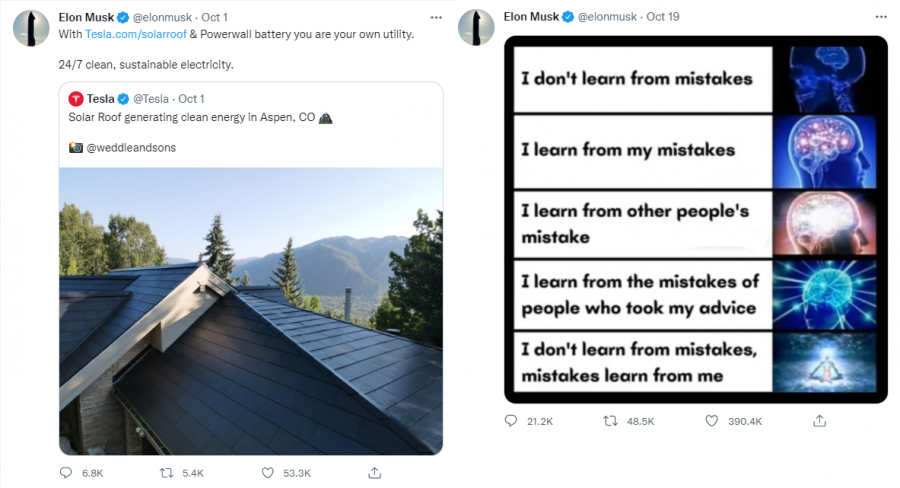
Figure 1: A comparison between a content-related tweet and a meme tweet with the uptake generated for both
The interaction that a tweet receives through replies, retweets and likes is called uptake. The more interaction that a tweet gets, the higher the uptake becomes because by replying, retweeting and liking it becomes visible to a wider audience. This makes uptake so very important to celebrities such as Musk because a higher uptake means more opportunity to spread your ideals (and products) which again will increase the number of fans. Uptake is in that regard a virtuous circle. The idea of audience labour is related to uptake which is the concept that the audience works with the hybrid media system by liking, sharing, clicking, commenting, viewing and posting which causes data to become more visible within the hybrid media system (Maly, 2020).
Musk uses Twitter in order to suit his goals which most likely are related to improving and increasing knowledge of Tesla, SpaceX and his other companies
The hybrid media system is a concept by Chadwick which shows that the different types of media (such as newspapers, television, websites and social media) work together and influence each other instead of merely co-existing (Chadwick, 2017). In addition, the actors within the system such as politicians, activists, and experts but also techboys such as Musk “create, tap, or steer information flows in ways that suit their goals and in ways that modify, enable, or disable the agency of others, across and between a range of older and newer media settings” (Chadwick, 2017, p. XI). Musk uses Twitter in order to suit his goals which most likely are related to improving and increasing knowledge of Tesla, SpaceX and his other companies. However, he does this through non-traditional methods because “he is extremely adept at using PR and digital social media to help form opinions and attitudes about the Tesla brand” (Light, 2020).
While his goals are related to the formal aspects of his life, namely his companies, his use of Twitter contains a multitude of other types of tweets. These memes, life philosophies, and opinions are what his fans react the most to and can sometimes cause repercussions for subjects outside the Twitter world such as cryptocurrencies.
Elon and his Musketeers’ discourse on Twitter
The communication between Musk and his fans is something quite bewildering to outsiders because of the sheer number of memes and inside jokes being used. Common themes are space, Musk’s dog Floki and doge(coin). As stated before, memes get the most interaction from fans with them mostly replying to Musk with more memes or variations of the meme that he originally posted. If Musk replies to these kind of memes or joking tweets, he usually does so by posting the crying with laughter emoji (🤣). This emoji pops up often in his discourse, sometimes accompanied by more text but often standing on its own to reply to a funny tweet by someone else. This kind of reply is interesting because it portrays him as an everyday man, someone ‘normal’ who will reply with an emoji when he finds something funny. This is again something that his fans can relate to.
This hope of being seen by Musk is what drives them to tweet at him and to try to elicit a direct response
The tweets that receive a more substantial reply are usually questions about Tesla or SpaceX which again lines up with the idea that his main goal of using Twitter is to generate attention for his companies. While the comments of most of Musk’s tweets are a combination of memes, jokes and people actually criticising him (the last category not being his fans), this is perhaps to be expected. Many of his fans reply to his tweets or tweet at him, in order to hopefully be seen by him. This hope of recognition is facilitated by the concept of the parasocial relationship. This concept explains the type of relationship an audience has with celebrities where they develop a sense of intimacy, perceived friendship and identification with the celebrity (Chung & Cho, 2017). The audience feels that there is a real connection while the celebrity in question does not know who they are individually. This hope of being seen by Musk is what drives them to tweet at him and to try to elicit a direct response. Users reveal hidden personal ideas and feelings with others due to the self-disclosing nature of social media which makes them feel an enhanced version of perceived intimacy which will in turn only make the parasocial relationship stronger.
A common way for a Musketeer to show their devotion is through memes and tweets but some fans decide to make a Musk colouring book or write a song devoted to the billionaire. Salina Marie Gomez made a colour book called The Illuminated Tweets of Elon Musk and in an interview, she says that “I wouldn’t consider myself a fan because [the word] implies a kind of a blind obsession with a celebrity” (Stephen, 2018). She supports his endeavours and calls those that disagree with him “consumers who “don’t want to be inconvenienced”” (Stephen, 2018). While she does not necessarily show herself as an ‘ordinary’ Musk fan, her twitter does reveal that she replies to Musk often with her drawings or simply by commenting on whatever he posted. She also mentions Musk in tweets not related to him and would even call Musk ‘her leader’ (see Figure 2). Even though Gomez herself might not identify as a fan, her behaviour indicates otherwise.
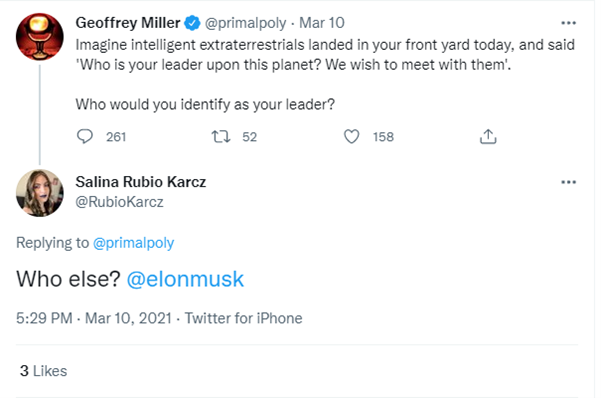
Figure 2: Tweet by Gomez which indicates her as a fan of Elon Musk.
Musk even has fans who write songs dedicated to him such as Jim Ocean and Brian Whistler with their song 'The Future Smells like Elon Musk'. Ocean has also been interviewed about this and there he says that Musk reminds him of people from the pages of a history book (Stephen, 2018). In the description box of the video, Ocean writes “we salute Elon Musk and his team. Keep up the amazing work!” (Ocean, 2018). This discourse shows clearly how genuinely proud he is of Musk and the song itself contributes to that.
Of course, these two fans are exemplary but it does show the kind of effect Elon Musk has on his followers. Gomez’s reply in which she calls Musk her leader is a good example of the way fans refer to Musk. They often call him ‘the best’, ‘their leader’, or they say that he is someone they look up to, admire or respect (see Figure 3). When people then critique him in the comments, they will fire back and disagree. They have blinding faith in him and his endeavours. His fans also tweet at him to let him know they bought a Tesla car or that they are really enjoying their car. His fans are extremely vocal in letting their support for Musk known.
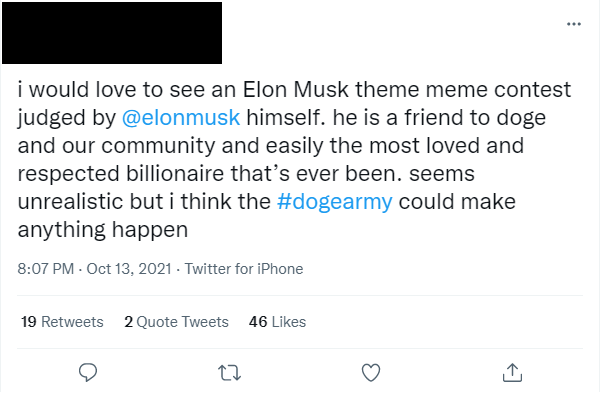
Figure 3: Example of a Musk fan praising him and calling him "the most loved and respected billionaire that's ever been".
Can Musk’s wealth solve world hunger?
Besides the joking around, Musk does address serious topics from time to time which are then replied to by his fans in a not so serious manner. At the end of October 2021, the director of the UN food scarcity organization announced that 2% of Musk’s wealth could solve world hunger (McSweeney & Pourahmadi, 2021). This headline was later changed in the wording “could help solve world hunger” but this original headline had already sparked heavy debate. A few days after the article was originally published on CNN Business, someone on Twitter posted a ‘fact check’ saying that 2% of Musk’s wealth would be 6 billion dollars and that the WFP (UN World Food Program) raised 8.4 billion dollars in 2020, so why did that not solve world hunger? Musk himself replied to this by saying that if the WFP could describe on Twitter how exactly 6 billion dollars would solve world hunger, that he would immediately donate that money as long as it was “open source accounting”, so that the public knows exactly what was done with the money (Musk, 2021). This reply caused a lot of discussion with a combined 19.1k replies on both tweets regarding this matter. Most of those replies are actual discussion points from people discussing how this could help world hunger and saying that Musk should just donate the money.
Both opposers and supporters of Musk have replied seriously to these tweets. Uncharacteristically, there are not that many memes or jokes posted underneath these tweets. So, the ones that are there stand out a lot more. One meme was posted by a (supposed) fan of an otter carrying pipes because “he needs those parts for his space ship, he’s going to otter space”. This kind of reply would have fit right in if it had been posted under one of Musk’s own meme tweets but now it comes across as crass and aloof because the tweets above are seriously discussing world hunger. This kind of reaction is quite characteristic of fans of Musk since they post any kind of meme or joke regardless of what the original tweet was about.
The dog that inspired a cryptocurrency
While most of his fans are regular followers, there is one special case of a ‘fan’ in the form of a cryptocurrency. The Floki Inu coin is named after Musk’s dog and the company has said that they were inspired by Musk’s tweet that his Shiba Inu will be called Floki (floki.com, n.d.). Elon Musk has a complicated relationship with cryptocurrency with him being able to affect various currencies simply by tweeting. But this coin is strongly connected to Musk due to its origin story. However, their aim is to become the most known and used cryptocurrency in the world, even calling themselves “the people’s cryptocurrency” (floki.com, n.d.). On the company’s blog it has been made clear that this is a project made by a community facilitated by the company behind the Floki coin. In their first blog post, they rally the community by saying “We need you, the Floki Vikings, to stand tall, be fearless and spread the word together as we all send Elons pup Floki to the moon!” (Floki Inu, 2021a).
The discourse used by Floki shows how their ideology is centred around giving the ‘average Joe’ power. Floki is not yet another cryptocurrency, it is the people’s cryptocurrency which combines “the power of memes with real utility and charitability” (floki.com, n.d.). Even though the coin is being presented in relation to memes and being of the people, Floki Inu has begun an offline marketing strategy costing almost 1.5 million dollars. The coin clearly wants to become more recognised and known offline which is interesting seeing as they are so firmly rooted in online culture (Floki Inu, 2021b). The campaigns started in London and Los Angeles and is spreading further to, for example, Dublin where I have seen the many advertisements first-hand (see Figure 4).
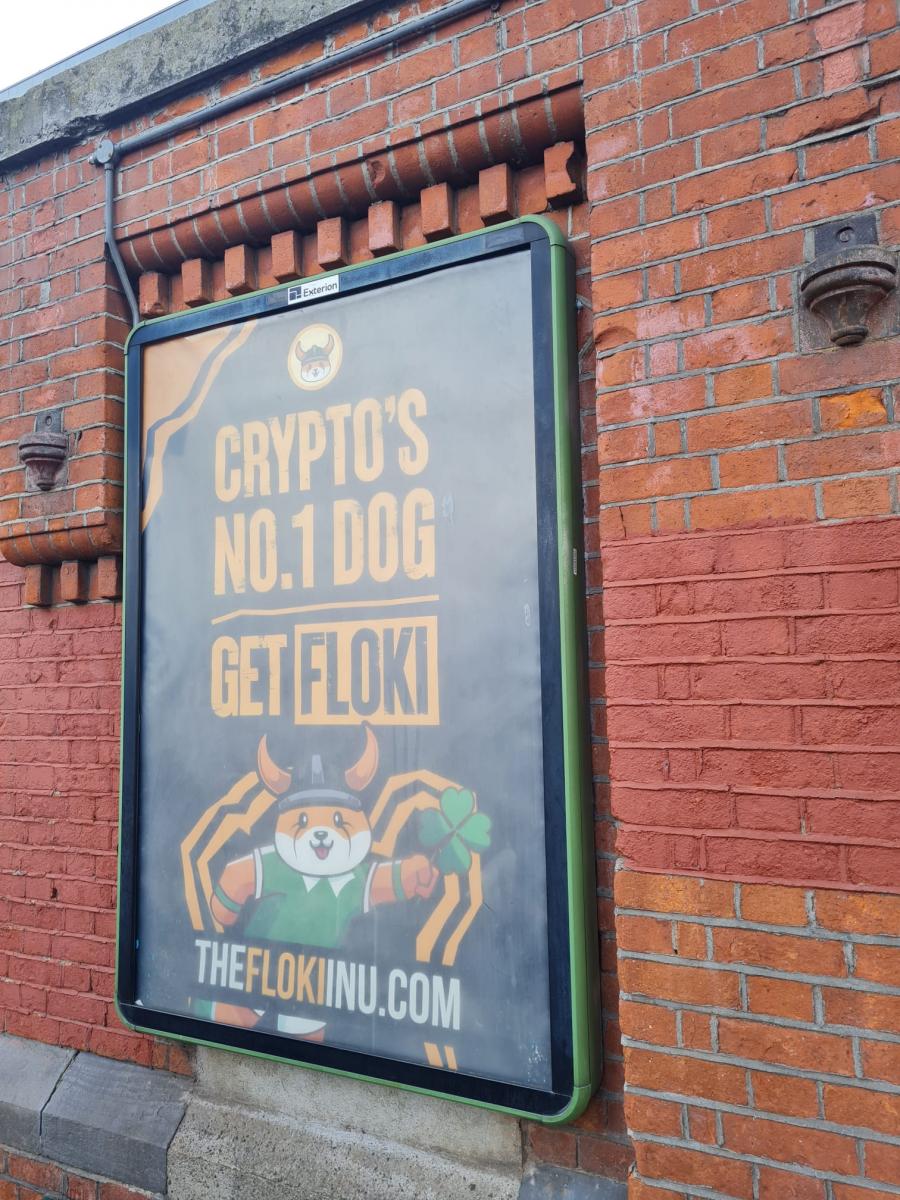
Figure 4: Floki Inu advertisement at a train station in Dublin.
While the mission is clear, to become the most popular cryptocurrency, the coin is still connected to Elon Musk forever which does not seem to be an issue for the company. On their website and on their blog, they do refer to Musk regularly but that discourse is very different from their discourse on Twitter. This is because on Twitter, they emulate the discourse of a ‘regular’ Musk fan. They tweet at him often and reply to his tweets, seemingly to try to be recognised and acknowledged by Musk which is behaviour seen from other Musk fans.
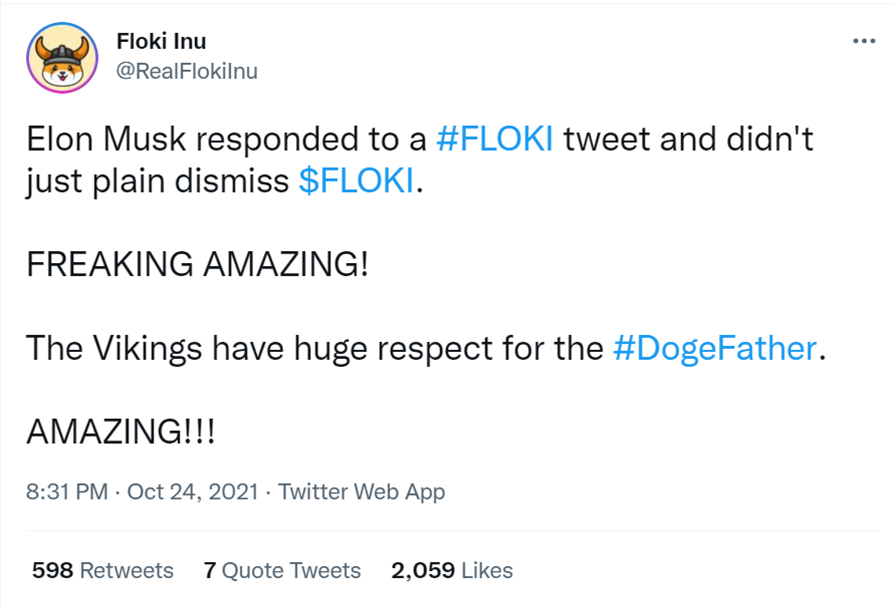
Figure 5: Tweet from the official Floki Inu Twitter account which shows that the discourse used by the company is similar to discourse from 'regular' Musk fans.
This expectation of recognition is facilitated by the parasocial relationship. @RealFlokiInu tweeting “FREAKING AMAZING!” and “AMAZING!!” shows the level of excitement that is apparently experienced because Musk responded (see Figure 5) (RealFlokiInu, 2021). Important to note is that Musk did not even reply directly to a tweet from that account, rather he replied to a tweet from someone asking what Musk thought about the Floki coin which was interpreted as Musk responding to the Floki currency. In his reply, Musk does not directly refer to the coin, rather he talks about the other cryptocurrency he owns and his advice on crypto. However, apparently an indirect response was enough to illicit such an enthusiastic reply simply because “he didn’t just plain dismiss $FLOKI” (RealFlokiInu, 2021).
Even though Floki Inu is a cryptocurrency and the tweets are all from the company itself, the discourse they use is similar to discourse used by fans. They are desperate to get recognition and they are overexcited when they do get it, even if it is indirect. Seeing as this is a company, we have to take into account that this could simply be a marketing trick to have other fans of Musk relate to the company and feel as if they are in the same boat. If the company succeeds with that, they might get some very loyal customers.
Especially since a cryptic tweet from Musk can see the price of the coin soaring up (Barsby, 2021). Musk posted a tweet of an image of Vikings having discovered the moon which apparently was enough of a sign for fans to start buying the coin. The name Floki is a reference to the TV series Vikings and the term ‘mooning’ or ‘to the moon’ are terms frequently used in the crypto world to refer to a coin having a sharp price increase. Even though Musk is not related to the Floki Inu coin in any way and has never publicly tweeted support, this cryptic tweet was enough of an incentive to buy the coin causing the price to go up.
Memes, space and dogs
One thing that is clear is that Elon Musk’s Twitter feed is filled with memes, space, and dogs (be it real or crypto-related dogs). While he tends to joke around and often posts funny pictures, his tweets also feature his many different interests and companies. As an actor in the hybrid media system, he knows how to work Twitter and his followers in such a way to achieve his own goals: making his companies more known and more successful. His audience works hard for him by liking, replying, retweeting, posting and sharing which makes his content even more visible. However, his funny content has a higher level of uptake than his actually serious content. His fans love Musk’s memes and jokes and they run with that by posting many, many memes underneath his tweets.
Even though we cannot be sure whether they would identify themselves as ‘fans’, Musk definitely has devoted followers as can be seen from the colouring book and song dedicated to him. The parasocial relationship Musk has with his followers is interesting because even though he does sometime reply to his fans, the connection is usually not much more than a simple laughing emoji. However, this does incentivise them to post more since it could happen that they get a reply. The Floki Inu coin is a very special type of fan seeing as it is a cryptocurrency and not a regular person. On their website and blog the discourse is relatively formal but on Twitter they act like any other Musk fan, tweeting at him to hopefully get a reply and they got overexcited when they did receive an indirect reply.
Imagine the type of effect that a direct call to action can have on his followers
Musk’s effect on real-world events should not be underestimated seeing as cryptic tweets can already lead to certain interpretations by his followers which cause changes in cryptocurrency prices. Next to that, the headline about 2% of Musk’s wealth being able to (help) solve world hunger can lead to Musk considering doing so. Imagine the type of effect that a direct call to action can have on his followers.
In short, Musk and his Musketeers’ discourse on Twitter is dominated by memes with Musk himself trying to intersperse this with serious content. Whether this actually works is the question since his fans seem to reply the same way to everything: by joking around.
References
Barsby, O. (2021). Elon Musk Viking tweet sees Floki Inu jump 18% in 30 minutes.
Blommaert, J. (2005). Discourse : a critical introduction (Ser. Key topics in sociolinguistics). Cambridge University Press.
Blommaert, J. & Varis, P. K. (2014). Conviviality and collectives on social media: Virality, memes and new social structures. (Tilburg Papers in Culture Studies; No. 108).
Chadwick, A. (2017). The hybrid media system. Politics and power. Oxford University Press.
Chung, S., & Cho, H. (2017). Fostering parasocial relationships with celebrities on social media: implications for celebrity endorsement. Psychology & Marketing, 34(4), 481–495.
Floki.com. (n.d.). Home.
Floki Inu. (2021a). The tale behind the meme: Elon, Floki and his fearless Viking army [Blog post].
Floki Inu. (2021b). Floki Inu to begin major marketing push in the month of October [Blog post].
Kress, G. (2010). Multimodality: A social semiotic approach to contemporary communication. London: Routledge.
Light, L. (2020). The natural: Elon Musk’s non-traditional approach to Tesla advertising.
Maly, I. (2020). Algorithmic Populism and the Datafication and Gamification of the People by Flemish Interest in Belgium. Trab. linguist. apl. vol.59 no.1 Campinas Jan./Apr.
McSweeney, E., & Pourahmadi, A. (2021). 2% of Elon Musk’s wealth could help solve world hunger, says director of UN food scarcity organization.
Musk, E [elonmusk]. (2021, October 31). But it must be open source accounting, so the public sees precisely how the money is spent [Tweet].
Ocean, J [Jim Ocean]. (2018, February 4). The Future Smells like Elon Musk [YouTube video].
Palmer, D. (2021). Tesla invests $1.5B in Bitcoin, plans to accept crypto payments.
RealFlokiInu. (2021, October 24). Elon Musk responded to a #FLOKI tweet and didn’t just plain dismiss $FLOKI. FREAKING AMAZING! The Vikings have huge respect for the #DogeFather. AMAZING!!! [Tweet].
Rella, E. (2021). Elon Musk sends crypto coin plummeting: ‘true value is building products’.
Shifman, L. (2014): Memes in Digital Culture. Cambridge, MA: The MIT Press.
Stephen, B. (2018). The gospel of Elon Musk, according to his flock.